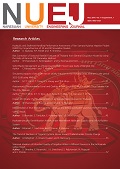Assessment of Groundwater Level and Quality: A Case Study in O Mon and Binh Thuy Districts, Can Tho City, Vietnam
Main Article Content
Abstract
The objective of this study was to assess the current state of groundwater use and exploitation, groundwater level trends and groundwater quality changes in O Mon and Binh Thuy districts, Can Tho city. In this study the following methods were used: (i) descriptive statistics, (ii) spatial interpolation by Kriging method, (iii) trend analysis. The results show that groundwater exploitation is mainly from the Pleistocene aquifer, of which 85.6% is exploited for industrial production purposes and urban water supply. This has led to the decrease in groundwater levels of the aquifer at an average rate of 24.05 cm/year in the 2001-2013 period. There are higher rates of groundwater level decrease in industrial zones which have more diverse types of water-usage than other areas. Groundwater quality has been assessed to be good up to the present, but this is tending to reduce due to chloride, organic matter and microorganism contamination. In particular, total coliform remains a leading pollution indicator with average probability in overall observation samples of 75.5% (with 376 MPN/100ml). Tra Noc industrial zone is defined as one of the areas with the highest micro-organism contamination with average probability of 89.0%, which is 141 times higher than the standard (Vietnam technical regulation on groundwater quality - QCVN09:2008/BTNMT).


